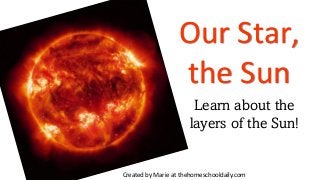
The Parts of the Sun
- 1. Our Star, the Sun Created by Marie at thehomeschooldaily.com Learn about the layers of the Sun! Learn about the layers of the Sun!
- 2. Genesis 1: 14-19 14 And God said, Let there be lights in the firmament of the heaven to divide the day from the night; and let them be for signs, and for seasons, and for days, and years: 15 And let them be for lights in the firmament of the heaven to give light upon the earth: and it was so. 16 And God made two great lights; the greater light to rule the day, and the lesser light to rule the night: he made the stars also. 17 And God set them in the firmament of the heaven to give light upon the earth, 18 And to rule over the day and over the night, and to divide the light from the darkness: and God saw that it was good. 19 And the evening and the morning were the fourth day.
- 3. Did you know that our sun is a star? Just like the stars in the sky, our Sun is a giant ball of burning gas. The main difference between our Sun and all the other stars we see is distance. It only takes 8.3 minutes for the light from the sun to reach Earth. This means that the sun is only 8.3 light minutes away, which is many thousands of times closer than any other star. A light-year is the distance light travels in one Earth year.
- 4. The Sun is by far the largest object in our solar system. It contains more than 99.8% of the total mass of the Solar System. Because it is so massive, the Sun exerts a lot of gravity, or pull, on the planets. Without its gravitational pull, the planets, asteroids, comets, and dwarf planets would fly off into space. Gravity is a force of attraction acting between all matter.
- 5. The Sun is about 70% hydrogen and 28% helium. This changes slowly over time as hydrogen atoms fuse together in the Sun’s core to form helium in a process called nuclear fusion. Since the Sun’s core experiences immense heat and pressure, atoms that are close to each other, fuse. When the atoms join, they create helium and energy.
- 6. The nuclear energy produced in the sun’s core is what becomes the light and heat we see and feel on Earth. It is our sole source of energy. Without the Sun, we could not survive on Earth.
- 7. Besides the core in the center of the Sun, there are two other layers: the radiative zone and convection zone. CORE RADIATIVE ZONE CONVECTION ZONE
- 8. The radiative zone surrounds the core and makes up about 70% of the Sun’s radius. In this zone, energy produced through nuclear fusion in the core moves steadily outwards as electromagnetic radiation. Photon carriers (light) bounce repeatedly, moving in a zigzag path, transferring energy towards the outer layers of the sun.
- 9. The convection zone is the outermost layer of the Sun’s interior. Energy in this zone moves towards the Sun’s surface through convection currents of heated and cooled gas. As the energy moves from the core to the outer layer of the Sun, light energy has converted to heat energy.
- 10. The photosphere is the first layer of the Sun’s atmosphere. It is the visible surface of the Sun. This is where the Sun’s light is emitted and then seen on Earth.
- 11. On the surface of the Sun, there are convection cells called granules. Granules are small at about 1000 km across. They are caused by convection currents of plasma in the Sun’s convective zone, which is directly below the photosphere.
- 12. The next layer of the Sun’s atmosphere is the chromosphere. It lies just outside the photosphere and is almost completely transparent. The chromosphere can be seen as a red glow just around the Sun. Chromosphere literally means “sphere of color.” It is best seen during a solar eclipse. A solar eclipse is when the moon partially of completely blocks the light from the sun. In a solar eclipse, the sun, moon, and earth are in alignment.
- 13. The corona is the outermost layer of the Sun’s atmosphere. Because the corona is so thin, you can only see it during a total solar eclipse, when the glare of the Sun itself (its photosphere) is blocked by the moon.
- 14. The high temperatures of the corona causes its particles to move at high speeds eluding the Sun’s gravity. This creates solar wind. Solar wind is a stream of electrically charged particles that emanate from the Sun’s corona.
- 15. Dark spots on the Sun’s surface are called sunspots. They appear dark because they are cooler than other parts of the Sun’s surface. The temperature of a sunspot is still very hot though—around 6,500 degrees Fahrenheit!
- 16. A solar prominence is a huge, reddish loop of gas that links different regions of the Sun together. It starts in the photosphere and extends out into the corona reaching thousands of miles into space. Scientists are not certain as to what causes a prominence, but magnetic forces are probable.
- 17. Solar flares are a sudden explosion of energy caused by tangling, crossing or reorganizing of magnetic field lines near sunspots. Solar flares are the most explosive events in our solar system.
- 18. To check out our other FREE resources, check out The Homeschool Daily! From the rising of the sun unto the going down of the same the LORD's name is to be praised. Psalm 113:1
